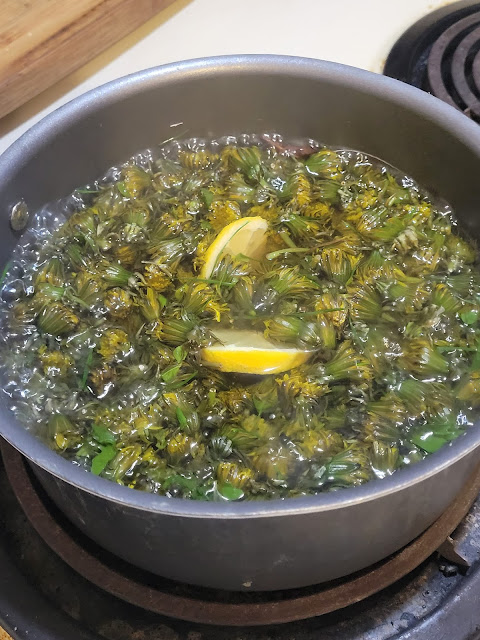Pineapple Palooza: Maximizing Flavor and Sustainability with Canned Pineapple, Homemade Juice, and Skin Powder
When life gives you a great deal on pineapples, why not make the most of it?
In this article, we'll explore the art of maximizing the potential of this beautiful fruit by showcasing three creative and sustainable ways to utilize every part of it. We'll start by canning the juicy flesh, then boil the skins to extract refreshing pineapple juice, and finally, transform the leftover skins into a flavorful powder for teas. Join us on this journey of culinary innovation where nothing goes to waste!
Recipe 1: Canned Pineapple
Ingredients:
- - Fresh pineapples
- - Water
- - Sugar (optional)
Related: Homemade Caramel Coffee Creamer: Indulgent Bliss in Every Sip
Instructions:
1. Start by preparing the pineapples. Remove the outer skin, crown, and the core.
2. Cut the pineapple flesh into desired shapes, such as rings or chunks.
3. Sterilize canning jars by washing them thoroughly with hot, soapy water and then placing them in a large pot of boiling water for 10 minutes. Remove and let them air dry.
4. In a large pot, combine water and sugar (if desired) to create a light syrup. Use approximately 1 cup of sugar for every 4 cups of water.
5. Bring the syrup to a boil, stirring until the sugar dissolves completely.
6. Pack the pineapple pieces into the sterilized jars, leaving a little space at the top.
7. Pour the hot syrup over the pineapples, ensuring they are fully submerged.
8. Carefully remove any air bubbles by running a knife or spatula along the sides of the jars.
9. Wipe the jar rims clean and seal them tightly with sterilized lids and rings.
10. Process the jars in a boiling water bath for about 15 minutes.
Related: Homemade Brown Sugar: A Sweet Revelation You'll Never Buy Again
11. Remove the jars from the water bath and let them cool to room temperature. You'll hear a satisfying "pop" sound as the lids seal.
12. Store the canned pineapples in a cool, dark place and enjoy them in various recipes or as a sweet treat on their own.
Recipe 2: Pineapple Juice
Ingredients:
- - Pineapple skins
- - Water
- - Sugar (optional)
Instructions:
1. Take the pineapple skins, including the core, and rinse them thoroughly.
2. Cut the skins into smaller pieces for easier handling.
3. Place the pineapple skins in a large pot and cover them with water.
4. Bring the water to a boil and let the skins simmer for about 30 minutes to extract the flavor.
5. Remove the pot from heat and allow the mixture to cool.
6. Strain the liquid through a fine-mesh sieve or cheesecloth, pressing down on the solids to extract as much juice as possible.
7. Taste the juice and add sugar if desired, stirring until it dissolves completely.
8. Refrigerate the pineapple juice for a refreshing drink or use it as a base for cocktails, smoothies, or even as a marinade for meats.
Recipe 3: Pineapple Skin Powder for Teas
Ingredients:
- - Dehydrated pineapple skins
Related: Homemade Blueberry Muffin Mix in a Jar: Easy and Delicious Breakfast Delights
Instructions:
1. Preheat your oven to the lowest temperature setting or use a food dehydrator according to its instructions.
2. Spread the pineapple skins in a single layer on a baking sheet or dehydrator tray.
3. Place the tray in the oven or dehydrator and leave the skins to dry for several hours or until they become crispy and brittle.
4. Once the skins are completely dry, remove them from the oven or dehydrator and let them cool.
5. Grind the dried pineapple skins into a fine powder using a spice grinder or blender.
6. Store the pineapple skin powder in an airtight container in a cool, dry place.
7. Add a teaspoon or two of the powder to hot water to make a fragrant and flavorful pineapple-infused tea. You can also use it as a delicious addition to smoothies or sprinkle it over desserts for an extra burst of tropical taste.
By seizing the opportunity of a great deal on pineapples, you've unlocked a world of possibilities that showcase both your creativity and sustainability.
From canning the succulent flesh to boiling the skins for refreshing juice and transforming the leftovers into a flavorful powder for teas, every part of the pineapple has found its purpose. So, next time you stumble upon a sale, remember that with a little ingenuity, you can turn a simple fruit into a sensational culinary adventure where nothing goes to waste. Cheers to the joy of pineapple perfection!























Comments